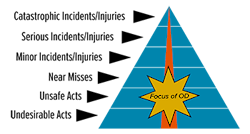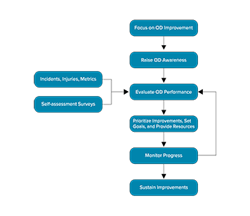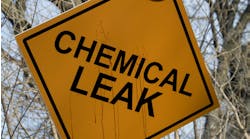Turn Up Process Safety Performance
Even highly trained people make mistakes. Some errors have minor consequences — but others potentially can lead to catastrophic incidents, especially in a high-hazard chemical process. An effective process safety management (PSM) program anticipates that people will make mistakes. As Figure 1 [1] depicts, such a program includes the three crucial elements: process safety systems that describe how to do work safely and correctly; a focus on safety culture and leadership; and an operational discipline (OD) program to help ensure correct execution of system requirements and cultural priorities every time.
OD is essential to achieve excellent process safety performance. Excellent performance means well-designed process safety systems that function day-to-day as intended and the prevention or effective mitigation of incidents that could result in fatalities, serious injuries, business interruption and environmental harm. Of course, poorly designed or implemented process safety systems and a weak organizational safety culture can significantly undermine the value of an OD program.
The U.S. Occupational Safety and Health Administration’s PSM regulation is over 25 years old and many companies in the United States and elsewhere have implemented PSM systems. For several years, companies also have focused on safety culture and leadership to help achieve their process safety goals. OD efforts — the commitment by everyone in an organization to always follow the systems and procedures that have been developed — often receive less attention but are crucial for reducing human error. If a company isn’t satisfied with its process safety performance, a new or renewed effort on OD may represent one of the best opportunities for improvement.
Human Error And OD
In an incident investigated by the U.S. Chemical Safety Board (CSB) [2], an operator opened the bottom valve of an operating polymerization reactor, apparently bypassing an active pressure interlock, instead of opening the bottom valve of a nearby reactor that was being cleaned. A large release of flammable material from the reactor ignited; the resulting explosion led to five fatalities and major damage to the facility. The CSB concluded, among other findings, that the facility “did not adequately address the potential for human error.” Of course, human error often is a major contributor to incidents [3, 4] as shown by industry investigations of incidents and near-misses.
Figure 1. Three elements contribute to an effective process safety program. Source: Ref. 1.
There are many causes of human error. Some common ones include [1]:
• human fallibility, capability, complacency and commitment;
• training issues, including procedure quality and training effectiveness;
• workplace environment, including accessibility of information and distractions;
• familiarity with the work being done and the time since it was last done;
• fitness-for-duty considerations, such as alcohol, drugs, stress and fatigue;
• urgency for completing a task quickly; and
• lack of risk recognition or sense of vulnerability.
The reality is that a company should anticipate human error and provide appropriate systems and safeguards to ensure errors don’t lead to serious injuries and other consequences, especially if work tasks include higher-risk activities involving significant process hazards. OD addresses human behavior in following required systems and procedures correctly, every time, to consistently achieve safer and more reliable operations. Developing an OD program [5–9] intended to support day-to-day commitment by all company personnel — in combination with well-designed process safety systems and a strong safety culture — can help both to minimize the potential for human error and confirm that process safety (and other) program requirements are rigorously followed.
A strong OD program can provide benefits in a variety of areas [1], including:
• Environmental, health and safety — prevention or reduction of workplace injuries, occupational exposures, process incidents, environmental releases, and associated costs;
• Operations — decrease in unscheduled shutdowns, poor process utilization, inefficient use of staff, incident-related downtime, and associated costs; and
• Quality — reduction in off-specification product, rework and waste, lower yields, poor quality, customer complaints, and associated costs.
The safety triangle (Figure 2) illustrates qualitatively that significant consequences, such as serious injuries or catastrophic incidents (at the top of the triangle) often (but not always) are the result of, or predicted by, a larger number of smaller near-miss events or unsafe acts and behaviors (at the bottom of the triangle). Focusing on minimizing or eliminating potential problems frequently can help prevent the more-serious events. An effective OD program works to reduce undesirable actions at the bottom of the triangle by encouraging and supporting correct actions in following program systems and procedures. This is especially important for higher-risk activities involving significant process (or other) hazards, where the base of the triangle may be very narrow — meaning that even one mistake or unsafe action can lead directly to a serious injury or other consequence. Ultimately, OD programs aim to help reduce the frequency and associated risks of human error.
Figure 2. Minimizing lapses lower in the triangle often can help forestall more-serious events. Source: Ref. 1.
Program Characteristics
A program must focus on both organizational and personal OD [1,6,7]. Organizational OD involves developing the programs and work environment to support strong OD as well as providing resources for OD improvement efforts. Organizational OD efforts closely relate to good safety culture and leadership practices, and supplement associated management systems to promote and achieve program goals. Personal OD characteristics target worker activities at all levels of the organization to ensure workers know what they need to do and perform their work correctly and safely every time.
Good OD performance doesn’t happen on its own. It requires continued management attention [7] — to demonstrate personal attention and dedication; provide appropriate resources, as needed; implement and use effective systems; monitor and evaluate actual performance; and develop and support effective processes to facilitate employee understanding, engagement and follow-through.
Organizational OD has four characteristics [1]:
• Leadership focus. Leaders emphasize and provide a positive work environment, managing processes and resources for effective programs and employee engagement. Leaders are personally involved and passionate for safety and model the behaviors they expect from everyone in their organization.
• Employee engagement. Employees at all levels of the organization understand and value the importance of safe work activities and contribute to organizational programs and activities.
• Procedure principles. Correct ways of doing work are defined and work is completed as planned, following reviewed and authorized systems and procedures.
• Housekeeping and workplace standards. Standards are established for maintaining safe equipment, tools and facilities. Employees are proud of their work environment and consistently maintain high levels of housekeeping
While related to safety culture, these characteristics serve to emphasize the OD aspects of effective programs. Leadership focus provides the foundation of any OD program — without it, priority and support for OD improvement can’t exist. Leadership also must promote strong employee engagement; too many uninvolved or uninterested employees will limit an organization’s ability to achieve robust performance. An important part of leadership focus, therefore, is providing the culture and work environment to engage employees at all levels of the organization, involving them as active participants in safety programs and in achieving strong performance. The most visible results of leadership focus and employee engagement are employees following approved systems and procedures, operating equipment within safe operating limits, and maintaining equipment and work areas in safe operating condition.
Personal OD has three characteristics [6]:
• Knowledge. The employee understands how to do the work task correctly and safely.
• Commitment. The person commits to doing the tasks the right way, every time.
• Awareness. The individual anticipates potential problems and recognizes unusual situations.
As Figure 3 highlights, all three personal characteristics are essential for achieving high levels of OD performance; a deficit in one area can increase the risk of an error. The goal is to have a prepared, skilled and suitable work effort that can effectively and safely deal with the existing work environment rather than an unquestioning focus on strict adherence to procedure when circumstances differ or change. Of course, procedures and training should cover possible deviations and the correct ways to respond to them to help mitigate any potential negative consequences. Efforts on personal OD necessarily relate to other major programs for reducing human error, including human factors analysis, behavior-based safety, human performance technology and human reliability assessment.
Figure 3. A deficit in any one area can undermine OD performance. Source: Ref. 6.
Elements Of An Effective Program
OD issues and problems typically are specific to an organization and local site, often varying in priority widely within the same organization or facility, based on different safety cultures, leadership, work activities, hazards, geographic locations and other factors. While common issues may exist within a larger organization — for example, no current focus on OD — improvement activities, which should not be prescriptive, must be evaluated locally to help identify and prioritize improvement opportunities and goals. For example, one site may have poorly developed procedures while another site may lack housekeeping standards. Both factors can affect OD performance but improvement requires different approaches. Effective OD programs, depending on the size of the organization or site, should consider one umbrella goal, for example, implementing an OD improvement program — but the details of specific activities for achieving better OD should be developed, prioritized and pursued based on specific local conditions and issues, as appropriate.
Figure 4 [1] shows a recommended approach for developing an effective OD program. The primary steps include:
• Focusing on OD improvement. Without specific management attention, organizationally and locally, OD is unlikely to improve in a sustained way.
• Raising OD awareness. Introduce all employees to what OD is and why it’s important. You can do this by discussing OD with employees in special workshops or meetings, safety meetings, shift meetings, etc.; reinforcement day-to-day in the workplace by management attention and practices is important. Solicit employee input on OD to help raise awareness and identify specific issues, causes and possible solutions for further evaluation.
• Evaluating OD performance. Assess current OD performance to establish a starting point and identify potential OD improvement opportunities, based on review of performance metrics, incident data, audit results, quality data and, potentially, targeted surveys.
• Prioritizing OD improvements. Focus on key areas for enhancing performance and opportunities that can produce tangible results quickly. Engage site employees for input, establish specific goals and timing milestones, and provide resources. Given the many competing priorities for resources, it’s generally better to limit the initial number of projects to help ensure success. Then, identify and add new projects as current ones finish.
• Monitoring progress. Establish metrics to check progress toward improvement goals and schedule periodic management reviews to support successful project completion. Also, pay attention to the greater work environment and, when appropriate, modify project goals based on new information/conditions. Recognize progress and successful project completion and continue to engage employees to support and provide input on progress.
• Sustaining improvements. As projects are successfully completed, there always will be additional improvement opportunities. Periodically repeat the previous steps, as needed, to identify, prioritize and implement new projects. Ensure that gains made are supported and preserved.
Figure 4. Following this approach can foster development of an effective OD program. Source: Ref. 1.
Making significant progress on improving OD takes time. A mix of projects to achieve quick and relatively easy improvements as well as longer-term more-substantial progress is ideal to establish value for the OD effort and build momentum. For example, simpler projects, such as developing checklists for higher-risk activities, take less time than needed for larger projects, such as significantly revising operating procedures or adding evaluation of OD in incident investigations or audits.
Improving OD is a continuous process. It involves a repeating cycle of identifying, completing and sustaining opportunities and then pinpointing new opportunities to pursue. You always must assess changes to technology, operations, hazards, etc.; these may provide additional needs for OD program efforts.
A variety of similar approaches are available for spurring organizational change. Here, as an example, are the best practices for leadership efforts to implement and sustain effective OD programs in the FLAME model [1]:
• Focus. Develop a vision to enable appropriate focus on OD, effectively communicate it to develop awareness and engage site personnel, and provide daily reinforcement through leadership attention and priorities.
• Leadership. Leaders act as role models committed to continuous improvement and excellent OD performance through use of effective, consistent leadership practices.
• Accountability. Organization, team and individual goals include a focus on OD with clear expectations on performance, feedback and recognition, as appropriate.
• Measurement. Metrics, audits and other tools are defined to periodically assess site activities, performance and progress toward goals.
• Engagement. Leaders provide a work environment that fosters the engagement and support of site personnel, based on good communication processes, employee input and involvement, and interdependent behaviors. Site personnel know they are important to success and that their contributions are valued.
It may make sense to assign an OD leader to give additional focus and accountability on achieving an effective program, especially for larger companies or facilities. Ultimately, the OD program should provide:
• Tools to document and support effective work practices, such as procedures, checklists, fitness-for-duty programs, management systems, etc.
• Training, both initially and via periodic refreshers, to confirm that workers understand how to complete their work correctly and safely; build value and commitment for following established procedures and systems every time; and support workers in anticipating and planning for potential work problems.
• Time for building capability and experience; completing work in a timely manner; and maintaining awareness of the work environment.
A Valuable Program
People make mistakes, sometimes with potentially catastrophic consequences. Effective process safety programs — built on foundations of safety culture and leadership, management systems, and operational discipline — anticipate and manage the likelihood of human error. As Jim Collins stated in “Good to Great” [10], “Sustained great results depend upon building a culture of self-disciplined people who take disciplined action.” If your metrics tell you that improved process safety performance is desirable to meet company goals, then an effective OD effort as part of your process safety program may provide the greatest opportunity for improving performance.
JAMES A. KLEIN is Minneapolis-based senior consultant for ABSG Consulting Inc. Email him at [email protected].
REFERENCES
1 Klein, James A., and Vaughen, Bruce K., “Process Safety: Key Concepts and Practical Approaches,” CRC Press, Boca Raton, Fla. (2017).
2 “Vinyl Chloride Monomer Explosion,” Report No. 2004-10-I-IL, U.S. Chem. Safety Bd., Washington, D.C. (2007).
3 Kletz, Trevor, “An Engineer’s View of Human Error,” 3rd ed., CRC Press, Boca Raton, Fla. (2001).
4 “Guidelines for Preventing Human Error in Process Safety,” Ctr. for Chem. Proc. Safety, A.I.Ch.E., New York City (1994).
5 Klein, James A., “Operational Discipline in the Workplace,” Proc. Safety Progr., pp. 228–235, Vol. 24, No. 4 (Dec. 2005).
6 Klein, James A., and Vaughen, Bruce K., “A Revised Model for Operational Discipline,” Proc. Safety Progr., pp. 58–65, Vol. 27, No. 1 (March 2008).
7 Klein, James A., and Francisco, Eduardo M., “Focus on Personal Operational Discipline to Get Work Done Right,” Proc. Safety Progr., pp. 100–104, Vol. 31, No. 2 (June, 2012).
8 “Conduct of Operations and Operational Discipline,” John Wiley & Sons, Hoboken, N.J. (2011).
9 Vaughen, Bruce K., Klein, James A., and Champion, John C., “Our Process Safety Journey Continues: Operational Discipline Today,” Proc. Safety Progr., pp. 478–492, Vol. 37, No. 4 (Dec. 2018).
10 Collins, Jim, “Good to Great: Why Some Companies Make the Leap… And Others Don’t,” HarperBusiness, New York City (2001).






